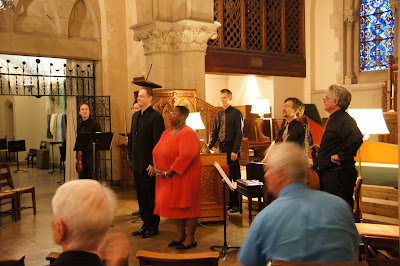
Should auld acquaintance be forgot,
and never brought to mind?
Should auld acquaintance be forgot,
and auld lang syne?
For auld lang syne, my dear,
for auld lang syne,
we’ll take a cup o’kindness yet,
for auld lang syne.
And surely you’ll buy your pint cup,
and surely I’ll buy mine!
And we’ll take a cup o’kindness yet,
for auld lang syne.
Every New Year’s Eve at midnight, millions of revelers the world over stumble through these famous words by the Scottish bard Robert Burns. Last week in New York, I encountered them under glass (literally, thanks to Pierpont Morgan’s eccentric collecting habits) and marveled again at their universality: they seemed somehow less corny in the original manuscript and earliest prints. Remembering “old times” — more precisely, the unique character of past events, things, and people — is crucial. Without memory, there is no culture.
On New Year's Eve 2011, Ars Lyrica Houston will savor a few of the greatest moments in our collective musical past, with major works by J. S. Bach on the subject of time. Then we party! Please note that our 2011 New Year’s Eve Gala is upstairs in the Grand Lobby of Sarofim Hall, not the Founder’s Club as in previous years. Good luck to all at the silent auction — may everyone win at least a “pint cup,” as Burns’ lyrics suggest!
Bach and Time program:
"Gottes Zeit ist die allerbeste Zeit," BWV 106
Suite in D Major, BWV 1068
"Ehre sei dir, Gott, gesungen" (Christmas Oratorio Pt. V), BWV 248/5
Program notes for Bach and Time:
Like most of us, Johann Sebastian Bach understood time to operate in multiple dimensions. His weekly responsibilities as the cantor and chief composer for Leipzig’s principal churches surely made him efficient with his own day-to-day time, since such a position required a new cantata every week. On a more spiritual level, Bach’s orthodox Lutheran milieu also conceived of time within a specifically Christian framework, encompassing everything from creation to eternity. God’s time (to use the locution of BWV 106: “Gottes Zeit”) is eternal, whereas human time is demarcated by salvation history, whose broad outlines are the giving of the Law, the revelation of the Gospels, and the obligation to live a moral life in the here and now.
Bach and his anonymous librettist juxtaposed all these ideas about time to great effect in Gottes Zeit ist die allerbeste Zeit (“God’s is the best time”). An intimation of eternity seems present from the opening notes of the Sonatina, whose archaic scoring for two recorders and two violas da gamba must have struck even its first hearers as an oddly quaint way to set such expressive and modern musical figures. Four singers then take center stage, for a cantata whose various sections announce that God’s time is eternal, that ours is brief, and that belief eventually leads us to a better place.
Unlike later cantatas organized around freestanding recitatives and arias, Cantata 106 looks backwards towards 17th-century models in its seamless shuttling from one kind of musical figure and scoring to another for each sentence or section of text. Given its old-fashioned form and its text, scholars have long assumed that Bach wrote this work for a funeral, most likely in 1707, at the very beginning of his career as a composer of church pieces. Its subtitle, “Actus Tragicus,” suggests a potentially broader purpose as well, in keeping with the German tradition of Trauerspiel or morality plays. Here, the tragedy is that of the human condition, which is overcome only in death through faith.
Bach’s Christmas Oratorio is actually a series of six separate cantatas for the Christmas – New Year season, each of which borrows considerable material from older compositions. Cobbled together in 1734, according to the autograph manuscript, this “oratorio” relies on the same alternation of text types and musical textures as do Bach’s passion settings, with Gospel narration by a tenor Evangelist, reflective arias for solo voices, and big “choral” movements leavened regularly by simple four-part chorales.
Part V (Ehre sei dir, Gott, gesungen), intended for the first Sunday after the New Year, begins in an irresistibly cheerful mood, with two oboes d’amore, strings, and voices tossing around the most joyous of musical ideas. The rest of this cantata focuses on the multifaceted role of the Star in the Christmas story: as signal to the Wise Men, as a light to the Gentiles, as a sign of danger for Herod, and as a beacon that continues to shine.
Perhaps the most timeless feature of this program is the beloved “Air” from Bach’s third “orchestral” Suite. Though the larger work otherwise follows a familiar French sequence of movements, complete with an initial “Ouverture” and some very fashionable dances, its best-known part is a humble little tune that Bach slips in just after an imposing opening movement—an unexpected little gift, perfect for this time of year!
© Matthew Dirst





